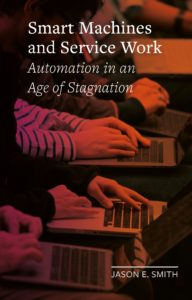Podcast: Play in new window | Download (Duration: 59:05 — 81.1MB)
 We’ll open with “Powerhouse” performed here by Don Byron off of Bug Music from 1996. Composed by Raymond Scott in 1937, “Powerhouse” was featured in over 40 Warner Bros. cartoons and perhaps best known for its use in the 1946 Looney Tunes cartoon “Baby Bottleneck” which stars Daffy Duck and Porky Pig.
We’ll open with “Powerhouse” performed here by Don Byron off of Bug Music from 1996. Composed by Raymond Scott in 1937, “Powerhouse” was featured in over 40 Warner Bros. cartoons and perhaps best known for its use in the 1946 Looney Tunes cartoon “Baby Bottleneck” which stars Daffy Duck and Porky Pig.
1946 is also the year the word, “automation,” is said to have been coined as workers in the Ford Motor Company made increasing use of a mechanized production line. Since then, scholars, journalists, and economists alike have projected the widespread and totalizing adoption of automation technologies across all sectors of the economy.
For nearly half a century, we have been bombarded with images of the future of automation. The “lights out” factories that manufacture goods without a hand from humans. Robots that care for the elderly.
These projections of the future of automation have not turned out to be as widespread as anticipated. The sectors of the economy that have adopted automation have seen minimal gains in productivity, while other sectors seem entirely immune to innovations in automation.
Why is this? We are in a crisis of stagnation. It can be seen in GDP growth, in labor productivity gains, in wage stagnation, in the rate of business investment since the turn of the century. Automation isn’t cheap, and businesses want to see sustained growth before spending money on fixed capital expenditures.
It’s not automation, then, that defines our era. It’s economic stagnation.
Corporations have responded to this crisis through a process called “cross-subsidization.” Corporations tend toward market monopolies, and in doing so they generate enough wealth to subsidize less lucrative parts of their business model. Facebook is free, but it is subsidized with advertisements. We can purchase goods from Amazon with a relatively small profit margin for the corporation itself, and yet the purchasing platform is subsidized by their web services platform.
Other companies rely on junk financing, cheap credit that keeps a company afloat but generates little to no profit. These barely-alive corporations are known as “zombie firms.”
The economic stagnation to which companies are responding has generated a novel arrangement of class conflict in the service sector.
Today, we’re told that as many as 85% of US workers labor in the service sector. If we usually think of “commodities” as distinct objects that are produced and then sold, the service sector complicates this equation. The service sector is characterized by the simultaneous production and consumption of commodities. Services can’t be quite so easily separated from the body of the person producing it as, say, a wooden chair that enters the marketplace at the behest of a furniture company. When you think of service work, think of the stylist who cuts your hair. Elementary school teachers. Bus drivers.
In his book Smart Machines and Service Work: Automation in an Age of Stagnation (published by Reaktion Books), Jason Smith argues against the claim that we are in the age of automation. We are, he argues, in a crisis of stagnation that fundamentally shapes the nature of class conflict. The outcomes of wage workers’ demands are inextricably tied to low productivity, and yet high productivity — which is associated with more success demanding higher wages — comes with greater exploitation of workers. Within the constraints of service work and stagnation, people across the world are organizing around their class interests. Lessons from the 2018 West Virginia teachers’ strike, the Gilet Jaunes movement in France, and graduate workers’ movements give us insight into what it means to get organized in our current moment: a crisis of stagnation.
 GUEST
GUEST
Jason E. Smith lives in Los Angeles. He has written extensively on contemporary politics and political economy, in journals including Artforum, The Brooklyn Rail, Commune, Critical Inquiry, and Radical Philosophy.
RELATED
The Upstarts and the Mandarins: Reflections on the Illusions of a Class (Interview with Jason E. Smith)
Jason E. Smith with Paul Mattick (The Brooklyn Rail)
At Your Service: Organizing in the Service Economy (Interchange with Fran Quigley)

MUSIC
“Powerhouse” performed by Don Byron, Bug Music (1996)
“The 99” Son Volt, Union (2019)
“Union” Son Volt, Union (2019)
“Automation Society” Son Volt, The Search (2006)
“Medicine Hat” Son Volt, Wide Swing Tremolo (1998)
CREDITS
Producer & Host: Doug Storm
Episode Producer: Bradi Heaberlin
Executive Producer: Kade Young
 WFHB Bloomington Community Radio
WFHB Bloomington Community Radio


